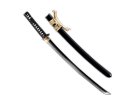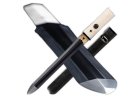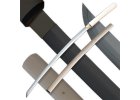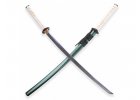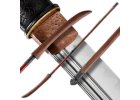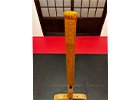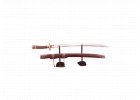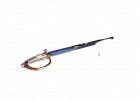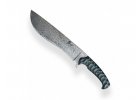Wenge is an exotic hardwood originating mainly from Africa, specifically the region around the equator such as Congo, Cameroon and Gabon. In the knife industry, wenge is popular due to its specific properties and aesthetic qualities. Here are some key points about wenge wood in the context of cutlery: Properties of Wenge Wood Density and hardness: Wenge is a very hard and heavy wood, which makes it resistant to wear and mechanical damage. Its density is approximately 880 kg/m³. Durability: This wood is resistant to insects and rot, making it ideal for long-term use. Texture and Appearance: Wenge has a very distinct and attractive texture with dark brown to black stripes that give it a unique look. Its color can range from dark brown to almost black. Stability: Wenge is very dimensionally stable, meaning it does not shrink or expand too much with changes in humidity, which is important for knife handles. Use of Wenge in the Cutlery Industry Knife Handles: Wenge is often used to make knife handles due to its strength and durability. Its attractive appearance adds aesthetic value and makes each knife unique. Decorative Elements: In addition to handles, wenge can also be used for decorative elements on knives, such as inlays or pins, which emphasize the overall design of the knife. Made to order: Due to its exotic nature, wenge is often chosen for custom and collector's knives, where the emphasis is on uniqueness and quality of materials. Caring for Wenge Wood Wenge, like other hardwoods, requires some care to maintain its appearance and properties: Oiling: Regular oiling helps keep the wood in good condition and enhances its natural beauty. Cleaning: The wood should be cleaned regularly and kept dry to prevent any damage. Wenge is therefore valued in the knife industry not only for its physical properties, but also for its aesthetic appearance, which brings uniqueness and elegance to the design of knives.
Login to your account
Your cart is currently empty.
If you do not know how to choose, do not hesitate to contact us. Our specialists will advise you.
Customer support:702 049 048info@dellinger.cz
More
- Akční nabídka
- Katanas, Japanese fighting knives and swords
- Sabres and Swords
- Hunting and pocket knives


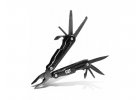
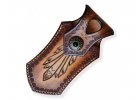

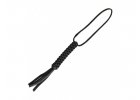
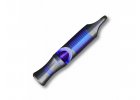

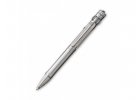
 Blade material
Blade material- Damascus carbon steel,
- Steel SKD11,
- M390 Bohler Microclean,
- Bohler N690 Stainless Steel,
- VG-10 Japanese steel,
- Carbon steel 14,260,
- 8Cr13MoV a 8CR14MoV,
- D2 steel,
- 9Cr18MoV,
- Steel 10Cr15CoMoV,
- Steel Nitro-V,
- steel CPM 20CV,
- Steel CPM S35VN,
- Steel CPM S90V,
- Blue Steel - Japanese steel,
- damascus steel - Stainless,
- Steel Sandvik 14C28N,
- 6AL4V titanium alloy,
- SK-5 Japanese steel,
- Stainless steel AUS-8,
- powder coated steel RWL-34,
- Steel 154CM (440C),
- India Wootz steel,
- DC53 steel,
- 6Cr - 6Cr13 Steel,
- 3Cr13 Steel
- Axes, hammers + machetes
- Exclusive and Limited Editions
- Bazaar - Outlet
- Yakuza PREMIUM clothes
- Reklamní předměty - merchandise
- Services
- Cold weapons Noze a katany
- Contacts shop
- Stores
- Brands
Používáme cookies, abychom Vám umožnili pohodlné prohlížení webu a díky analýze provozu webu neustále zlepšovali jeho funkce, výkon a použitelnost. Více informací

_-_edited.png)
